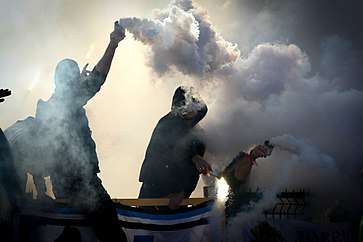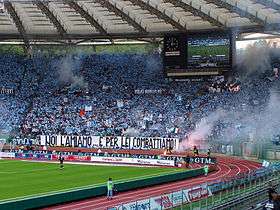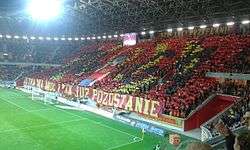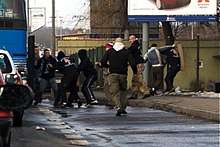Ultras


Ultras are a type of football fan renowned for ultra-fanatical support. They are predominantly followers of association football teams.
The behavioural tendency of ultras groups includes the use of flares (primarily in tifo choreography), vocal support in large groups and the displaying of banners at football stadiums, all of which are designed to create an atmosphere which encourages their own team and intimidates opposing players and supporters. The use of elaborate displays in stadiums often is common, as well.
The actions of ultras groups are occasionally extreme and may be influenced by political ideologies such as conservatism or socialism, or views on racism, ranging from avowed nationalists to anti-fascist.[1] In some instances, this goes to the point where the passionate and loyal support of one's team becomes secondary to the theoretical ideology of the ultras phenomenon.[2] In recent decades, the culture has become a focal point for the movement against the commercialisation of sports and football in particular.[3]
History
The origin of the ultras movement is disputed,[4] with many supporters groups from various countries making claims solely on the basis of their dates of foundation. The level of dispute and confusion is aided by a contemporary tendency (mainly in Europe) to categorize all groups of overtly fanatical supporters as ultras. Supporters groups of a nature comparable to the ultras have been present in Brazil since 1939, when the first torcida organizada was formed. Inspired by the torcidas and the colourful scenes of the 1950 World Cup, supporters of Hajduk Split formed Torcida Split on 28 October 1950.[5] The group is often cited as the oldest torcida style group in Europe.
One country closely associated with the ultras movement is Italy.[4][6] The first Italian ultras groups were formed in 1951, including the Fedelissimi Granata of Torino. The 1960s saw the continuing spread and development of the culture with the formation of the Fossa dei Leoni and Boys San groups, the former often regarded in Italy as the first full-fledged ultras group. The term Ultras was used as a name for the first time in 1969 when supporters of Sampdoria formed the Ultras Tito Cucchiaroni and fans of Torino formed the Ultras Granata. The style of support that would become synonymous with Italian football developed most during the 1970s as more groups formed including the radical S.S. Lazio Ultras in 1974 with a strong predominance of fascist slogans and chants amongst other groups such as Hellas Verona supporters. The active support of the ultras became more apparent, in contrast with the "traditional" culture, choreographic displays, signature banners and symbols, giant flags, drums and fireworks became the norm as groups aimed to take their support to higher levels.[7] The decade also saw the violence and unrest of Italian society at the time overlap with the ultras movement, adding a dimension that has plagued it ever since.[8]
The ultras movement spread across Europe during the 1980s, 1990s and 2000s, starting with the countries geographically closest to Italy.[9]
Europe

United Kingdom
Green Brigade are an ultras group that follow Celtic F.C. and regularly make tifo displays and often voice support for the IRA.[10] Although it has been theorised the English Premier League is immune to an ultras movement because of all-seater stadiums, expensive tickets and punishments for hooliganism, Crystal Palace is a team in the top flight that have a well known ultras following called the Holmesdale Fanatics. The group has been said to cause anxiety among other fans and workers at the football club and has been condemned for lighting flares, coin-throwing incidents and moshing.[11][12][13] Several non-league football teams in England have ultras groups that are left-wing, anti-fascist, anti-racist and anti-sexist such as the fans of Dulwich Hamlet F.C. that have a group called the ComFast Chapter who are openly communist.[14][15] A Vice article claims the far-right Casuals United is at war with anti-fascist football ultras and have come into conflict with the Clapton Ultras and had already caused the disbandment of the anti-EDL Inter Village Firm that followed Mangotsfield United.[16][17]
Africa

| Stadium | Club | Noum |
|---|---|---|
| July 5, 1962 Stadium | MC Alger | - Ultras Verde Leone 2007 - Ultras Green Corsaires 2012 - Ultras the Twelfth Player 2012 - Groupe Vert et Rouge 2013 |
| Stade 20 Août 1955, Skikda | JSM Skikda | - Ultras Senza Confine 13 - Ultras Ouled Russicada 2015 |
| August 20, 1955 Stadium (Algiers), | CR Belouizdad |
- Ultras Fanatic Reds 09 |
| Stade 8 Mai 1945, Setif | ES Setif | - Ultras Inferno 10 |
| Stade Omar Hamadi, Setif | USM Alger | - Ouled El Bahdja |
| Mohamed Hamlaoui Stadium, Constantine | CS Constantine | - Ultras Sanafirs 2009 -Ultras Loca Ragazzi 2010 - Ultras Green Army 2012 - Ultras Los Guerreros 2015 |
| Ahmed Zabana Stadium, Oran | MC Oran | - Ultras Red Castle 2011 - Ultras Leones Rey 2009 |
| Maghrebi Unity Stadium | MO Bejaia | - Ultras Granchio 09 - Ultras Saldae Kings 2010 - Ultras Free Men 15 - Ultras Pirate Boys 16 |
| May 19, 1956 Stadium | USM Annaba | - Les indepandants de bone 12 - Ultras Sparta Rosso 2015 |
| November 1, 1954 Stadium (Tizi Ouzou), Tizi-Ouzou | JS Kabylie | - Ultras Kabylie Boys 09 - Ultras The Leader 2013 - Ultras Samba Boys 2013 |
| August 20, 1955 Stadium (Algiers), Algiers | NA Hussein Dey |
- Ultras Dey Boys 09 |
| Mohamed Boumezrag Stadium, Chlef | ASO Chlef |
- Ultras Polina 10 |
| November 1, 1954 Stadium (Batna), Batna | CA Batna | - Ultras Aurès Boys 2009 - Ultras Furia Roja 2013 |
| Stade Imam Lyes, Medea | O Medea | - Ultras Matador 26 - Ultras Titery Army 2015 |
| February 24, 1956 Stadium, Sidi Bel Abbès | USM Bel Abbès |
- Curva Nord |
| November 1, 1954 Stadium (Algiers) | USM El Harrach |
- Grinta Curva |
| August 20, 1955 Stadium, Bordj Bou Arréridj | CA Bordj Bou Arréridj | - Ultras Commandos 2008 - Ultras Pavoré 2015 |
| April 13, 1958 Stadium, Saida | MC Saida |
- Ultras Méga Boys 2007 |

| Stadium | Club | Noum |
|---|---|---|
| Stade Mohamed V | Raja Casablanca | - Ultras Green Boys 05 - Ultras Eagles 06 |
| Stade Mohamed V | Wydad Casablanca | - Ultras Winners 2005 |
| Ibn Batouta Stadium | Ittihad Riadi Tanger | - Ultra Hercules 2007 |
| Prince Moulay Abdellah Stadium | Association Sportive des FAR | - Ultras Askary 2005 - Black Army 1427 |
| Stade de Marrakech | Kawkab Marrakech | - Ultras Crazy Boys 2006 |
| Stade Adrar | Hassania Agadir |
- Ultras Imazighen 2006 |
| Stade Saniat Rmel | Moghreb Tetouan | - Ultras Los Matadores 2005 - Ultras Siempre Paloma 2006 |
| Stade Mimoun Al Arsi | Chabab Rif Al Hoceima | - Ultras Los Rifeños 2012 |
| Stade El Massira | Olympic Safi | - Ultras Shark 2006 |

The clubs in Egypt became a major political force during the uprising against Mubarak in 2011, but were known for long-standing animosity with the police.[18] When 38 members of the Ultras Devils were arrested in Shebeen al-Kom for "belonging to an illegal group" plus additional violent offences, it was seen as a crackdown on the organizations by authorities.[18] Ultras in Turkey have also played a role in the 2013 protests in Turkey, with fans of arch-rivals Galatasaray, Fenerbahçe and Besiktas shielding protesters and allying against police violence. Police responded with raids in the Besiktas neighbourhood, the main breeding ground of ultras of the Beşiktaş club, the Carsi Group.[19]
In 2013, the Associated Press stated that the Egyptian Ultras network was one of the most organized movements in Egypt after the Muslim Brotherhood.[18]
| Stadium | Club | Noun |
|---|---|---|
| Cairo International Stadium | Al Ahly SC | - Ultras Ahlawy |
| Cairo International Stadium | Zamalek SC | - Ultras White Knights |
| Port Said Stadium | Al-Masry SC | - Ultras Green Eagles |
| Suez Stadium | Suez Montakhab | - Ultras Suez Fedyan |
| Ghazl El Mahalla Stadium | Ghazl El Mahalla SC | - Ultras Whales 2008 |
| Ismailia Stadium | Ismaily SC | - Ultras Yellow Dragons |
| Alexandria Stadium | Al Ittihad Alexandria Club | - Ultras Green Magic |

| Stadium | Club | Noun |
|---|---|---|
| Stade Olympique de Radès | ES Tunis | - Curva Sud Tunis |
| Stade Olympique de Radès | Club Africain | - Curva Nord Tunis |
| Stade Taïeb Mhiri | CS Sfaxien | - Curva Nord Sfax |
| Stade Olympique de Sousse | ES Sahel | - Curva Nord Sousse |
Characteristics
Ultras groups are usually centred on a core group of founders or leaders (who tend to hold executive control),[20] with smaller subgroups organized by location, friendship or political stance. Ultras tend to use various styles and sizes of banners and flags bearing the name and symbols of their group.[20][21] Some ultras groups sell their own merchandise to raise funds for performing displays.[20][22] An ultras group can number from a handful of fans to hundreds or thousands, with larger groups often claiming entire sections of a stadium for themselves. Ultras groups often have a representative who liaises with the club owners on a regular basis, mostly regarding tickets, seat allocations and storage facilities.[20] Some clubs provide groups with cheaper tickets, storage rooms for flags and banners and early access to the stadium before matches in order to prepare displays. These types of favoured relationships are often criticized when ultras groups abuse their power.[1]
Hooliganism

While ultras groups can become violent, the majority of matches attended by ultras conclude with no violent incidents. Unlike hooligan firms, whose main aim is to fight hooligans of other clubs, the main focus of ultras is generally to support their own team.[23] Some hooligans try to be inconspicuous when they travel; usually not wearing team colours, in order to avoid detection by the police. Within the ultra or hooligan culture however, those dressing to "blend in" would be referred to as casuals, which is viewed by some as a branch of hooliganism, yet still maintaining its own independence and culture. Ultras tend to be more conspicuous when they travel, proudly displaying their scarves and club colours while arriving en masse, which allows the police to keep a close eye on their movements.
See also
References
- 1 2 "The dark heart of Italian soccer". CBC Sports. 15 April 2005. Retrieved 18 January 2011.
- ↑ "Fan tragedy sends the fight against Ultras back to square one". The Guardian. 12 November 2007. Retrieved 18 January 2011.
- ↑ "Are German fans really turning against the beautiful game?". The Guardian. 7 April 2008. Retrieved 18 January 2011.
- 1 2 "We Don't Fight, We Paint Flags Instead". In Bed With Maradona. 2 November 2010. Archived from the original on 13 July 2011. Retrieved 5 February 2011.
- ↑ "Povijest". Torcida.hr (in Croatian). Archived from the original on 17 February 2011. Retrieved 5 February 2011.
- ↑ "Ultra sensitive". When Saturday Comes. April 2007. Retrieved 18 January 2011.
- ↑ "Ultras rule?". Football Italia. 28 October 2009. Retrieved 18 January 2011.
- ↑ Alberto Testa, Gary Armstrong (2010). Football, Fascism and Fandom. A&C Black. ISBN 978-1-4081-2371-3.
- ↑ "Passion, politics and violence: A socio-historical analysis of Spanish ultras". Informaworld. March 2005. Retrieved 18 January 2011.
- ↑ "The Green Brigade: Celtic fan group's timeline of colour and controversy". The Scottish Sun. 2017-07-22. Retrieved 2018-04-10.
- ↑ Bakowski, Gregg (2016-10-23). "Ultra culture could help Premier League terraces take positive steps". the Guardian. Retrieved 2018-04-10.
- ↑ "Palace 'ultras' causing anxiety". ESPN.com. Retrieved 2018-04-10.
- ↑ Barker, Matthew. "When Saturday Comes - Crystal Palace ultras under pressure from club and fans". www.wsc.co.uk. Retrieved 2018-04-10.
- ↑ "Eastbourne Town's 'ultras' are game for a laugh and making football welcome to all". iNews. 2017-11-16. Retrieved 2018-04-10.
- ↑ "London's Left-Wing Utopian Non-League Ultras Are Reclaiming Football". Vice. 2015-01-05. Retrieved 2018-04-10.
- ↑ "The English Far-Right's War On Anti-Fascist Football Ultras". Vice. 2015-02-13. Retrieved 2018-04-10.
- ↑ "The FA – Kicking anti-racism out of football". Supporters Not Customers. 2014-01-16. Retrieved 2018-04-10.
- 1 2 3 el Deeb, Sarah (14 March 2013). "Egypt: 38 soccer fans charged with violence". USA Today. Associated Press.
- ↑ "Ultras: The Surprise Kids ff Turkey’s Uprising", Al Monitor website (posted 4 June)
- 1 2 3 4 "Ultras pull the strings as Italy descends into chaos". The Guardian. 4 February 2007. Retrieved 5 February 2011.
- ↑ "Gruppi". asromaultras.org (in Italian). Retrieved 5 February 2011.
- ↑ "AS Roma Ultras". asromaultras.org (in Italian). Retrieved 18 January 2011.
- ↑ "Ultra vires". Spiked. 9 February 2007. Archived from the original on 24 February 2011. Retrieved 18 January 2011.
Further reading
| Wikimedia Commons has media related to Ultras. |
- Dyal, Mark. (2018) Hated & Proud: Ultras Contra Modernity, London, Arktos.
- Guerra Nicola (2014). "Il discorso e la lingua speciale del calcio, una definizione inclusiva. I meccanismi di creazione dei neologismi e le dinamiche di contatto e interferenza" Annals of the University of Craiova "". External link in
|title=(help); Missing or empty|url=(help) - Guerra Nicola (2011). "Meccanismi e significati linguistici di un'identità contemporanea: analisi dello spazio linguistico di una tifoseria ultras di calico" Annals of the University of Craiova"". External link in
|title=(help); Missing or empty|url=(help) - Guerra Nicola, Valentina Imperi, Claudia Vardanega (2010). "I Poeti della Curva: Un'analisi sociolinguistica degli striscioni allo stadio" Aracne"". External link in
|title=(help); Missing or empty|url=(help) - Prof. Dr. Gunter A. Pilz: "International Conference on Ultras. Overview of the Ultra culture phenomenon in the Council of Europe member states in 2009" (PDF). (195 KB) Leibniz University Hanover, 18 January 2010.
- Testa, A. and Armstrong, G. (2008). "Words and actions: Italian ultras and neo-fascism" Social Identities, vol. 14 (4), pp. 473 – 490
- Testa, A. (2009) "UltraS: an Emerging Social Movement", Review of European Studies, vol. 1 (2), 54-63
- Testa, A. (2010). Contested Meanings: the Italian Media and the UltraS. Review of European Studies, vol 2(1), 15-24
- Testa, A. and Armstrong, G. (in press; November 2010). Football, Fascism and Fandom: The UltraS of Italian Football, A&C (Bloomsbury), London, Black Publishers.
- "Violence Threats to Italian Iconic Landmarks and Stadiums". TAL Global Corporation.